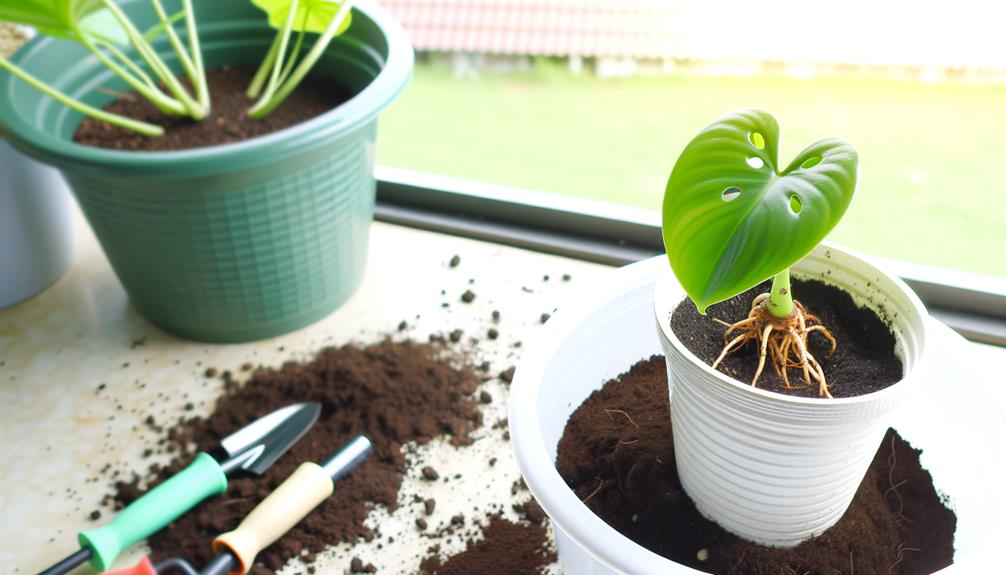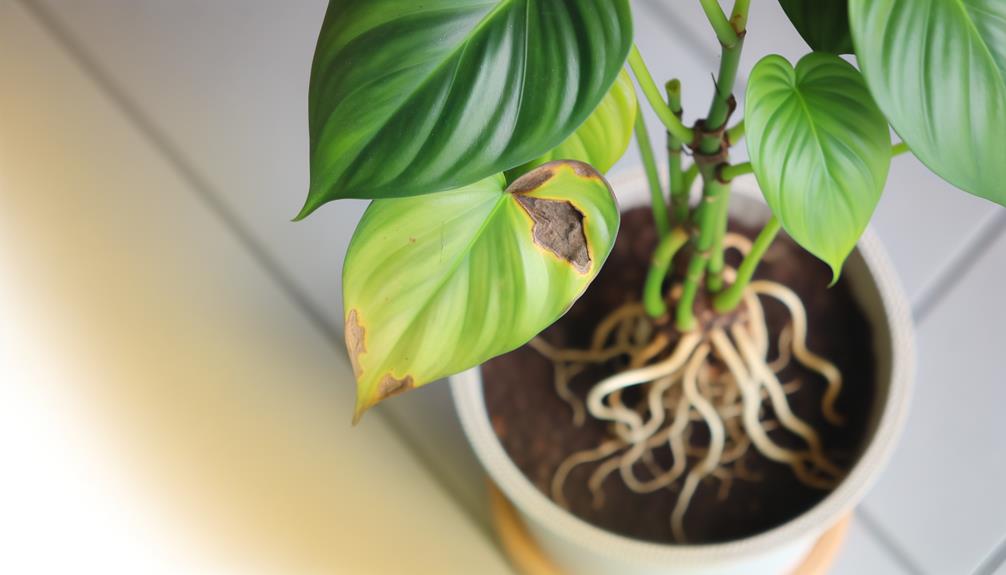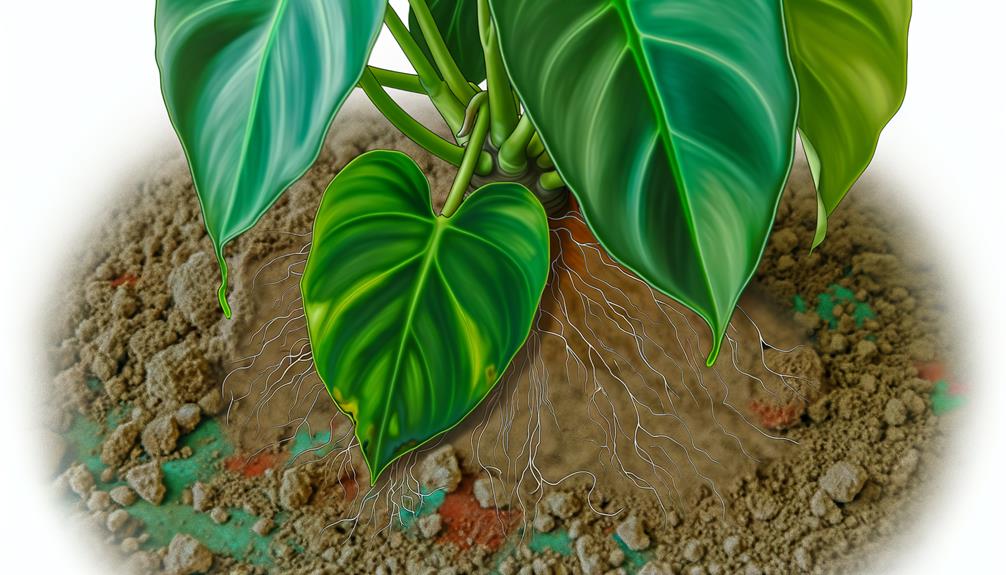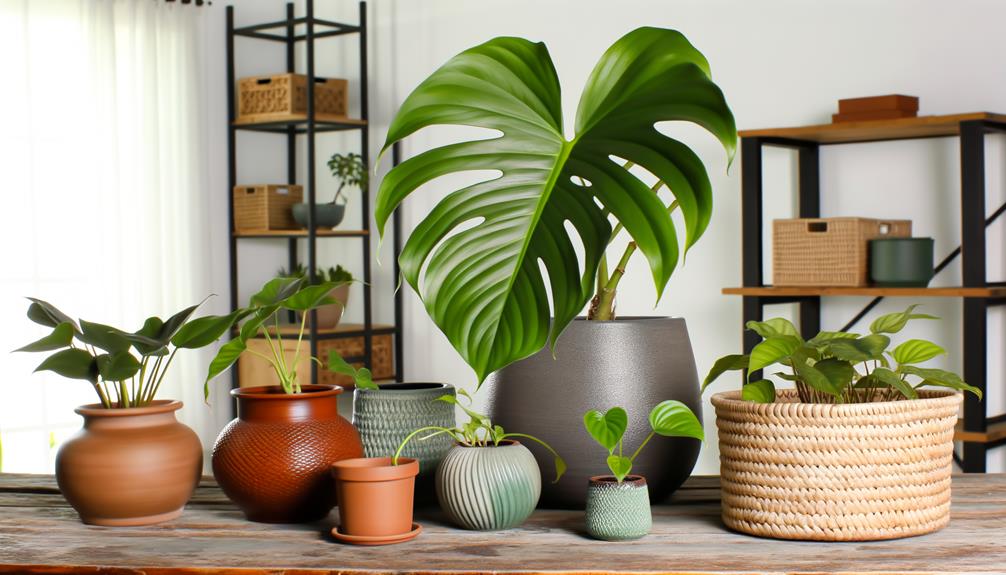When Should I Repot a Heartleaf Philodendron?
Repot your Heartleaf Philodendron when roots emerge from drainage holes or spiral within the pot. Indicators such as stunted growth and smaller leaves also signify the need for repotting due to root system constraints.
Soil quality decline, evidenced by nutrient depletion or salt accumulation, necessitates a refreshed potting medium. Perform repotting in early spring to minimize stress and maximize root expansion during the active growth phase.
Select a slightly larger pot with adequate drainage to secure healthy root aeration. Following these guidelines will promote plant vigor and sustained health.
Further insights into detailed practices can enhance plant care.

Key Takeaways
- Repot when roots emerge through drainage holes or spiral inside the pot.
- Look for stunted growth and diminished leaf size as indicators.
- Refresh the soil when it shows signs of nutrient depletion or salt accumulation.
- Perform repotting in early spring to minimize stress and promote growth.
- Choose a pot slightly larger with adequate drainage for optimal root health.
Signs of Root Bound

One of the primary indicators that a Heartleaf Philodendron is root bound is the emergence of roots through the drainage holes at the bottom of the pot. This phenomenon occurs when the root system has outgrown its current container, seeking additional space and resources.
In such cases, the roots may also spiral around the pot's interior, forming a dense, compact mass. To confirm, gently remove the plant from its pot and inspect the root structure. If the roots are tightly wound or encircling the soil, it indicates the need for repotting.
Choose a new pot with a diameter 2-3 inches larger than the current one, ensuring adequate room for growth while preventing future root binding.
Stunted Growth Indicators
Notably, stunted growth in a Heartleaf Philodendron can be seen through diminished leaf size and slower-than-expected development of new shoots.
When a philodendron's growth becomes compromised, it often indicates that the plant's root system has outgrown its container, limiting its access to necessary nutrients and water.
Furthermore, the decreased leaf size is a clear physiological response to the limited resources available within the confined root environment.
Observing these symptoms, horticulturists recommend examining the root ball; if it appears densely packed and encircling the pot, it is a strong indication that repotting is necessary.
Shifting the plant to a larger container can alleviate these constraints, leading to renewed vigor and growth.
Soil Quality Decline

Soil quality decline in a Heartleaf Philodendron is often characterized by the depletion of essential nutrients, leading to subpar plant health and growth. Over time, the organic matter in the potting mix decomposes and diminishes, reducing the soil's ability to retain moisture and nutrients.
Additionally, the accumulation of salts and other residues from fertilizers can further degrade soil quality, impacting root function. To address this, it is essential to refresh the potting medium periodically. Select a well-draining mix enriched with organic matter, such as peat moss or compost, to restore nutrient availability and aeration.
Monitoring the plant's health and soil condition will help in determining the best timing for repotting, ensuring robust growth and well-being.
Seasonal Timing
Understanding the best seasonal timing for repotting a Heartleaf Philodendron is essential to guarantee minimal stress and maximum recovery for the plant. The ideal period for repotting is during the early spring months. This timing coincides with the onset of the plant's active growth phase, allowing it to adapt rapidly to new soil conditions and pot environments. Repotting during this period ensures that the root system can expand efficiently, assimilating nutrients and moisture more effectively.
Avoid repotting in the late fall or winter when the plant enters dormancy; during these months, physiological processes slow down, reducing the plant's ability to recover from transplant shock. Maintaining proper seasonal timing is crucial to sustaining a healthy Heartleaf Philodendron.
Choosing the Right Pot

Choosing a suitably sized pot with adequate drainage is crucial for the health and growth of a Heartleaf Philodendron. The selected pot should ideally be 1-2 inches larger in diameter than the current one to accommodate root expansion without causing waterlogging.
Pots made of materials like terracotta or ceramic provide better airflow and moisture regulation. Make sure the new pot has enough drainage holes to prevent root rot, a common issue in philodendrons. Avoid selecting excessively large pots, as surplus soil can retain moisture and lead to fungal infections.
Additionally, using a saucer beneath the pot can help gather excess water, promoting a balanced moisture environment. These considerations will ensure optimal growth conditions for your Heartleaf Philodendron.
Repotting Best Practices
When repotting a Heartleaf Philodendron, make certain that the plant's roots are gently loosened from the old soil to promote healthy root development in the new potting medium. Select a pot that is 1-2 inches larger in diameter than the current one, guaranteeing it has adequate drainage. Use high-quality, well-draining potting soil enriched with organic matter to support nutrient uptake. Water the plant thoroughly after repotting to settle the soil and reduce transplant shock. Avoid direct sunlight for a few days to allow the plant to acclimate.
| Step | Action | Notes |
|---|---|---|
| 1 | Choose a new pot | Make certain it is 1-2 inches larger |
| 2 | Loosen roots | Gently remove old soil |
| 3 | Add fresh potting soil | Use well-draining, nutrient-rich soil |
| 4 | Water thoroughly | Helps in settling the soil |
| 5 | Avoid direct sunlight | Allows acclimation to new conditions |
Conclusion
Repotting a heartleaf philodendron is necessary when root-bound signs emerge, indicated by roots encircling the pot's perimeter. Stunted growth, deteriorating soil quality, and seasonal shifts further necessitate this action.
Selecting an appropriately-sized container and adhering to precise repotting practices guarantees ideal plant health. This process revitalizes the philodendron, allowing roots to unfurl and breathe, soil to replenish with nutrients, and leaves to regain their lush, vibrant splendor, fostering a thriving botanical specimen.






